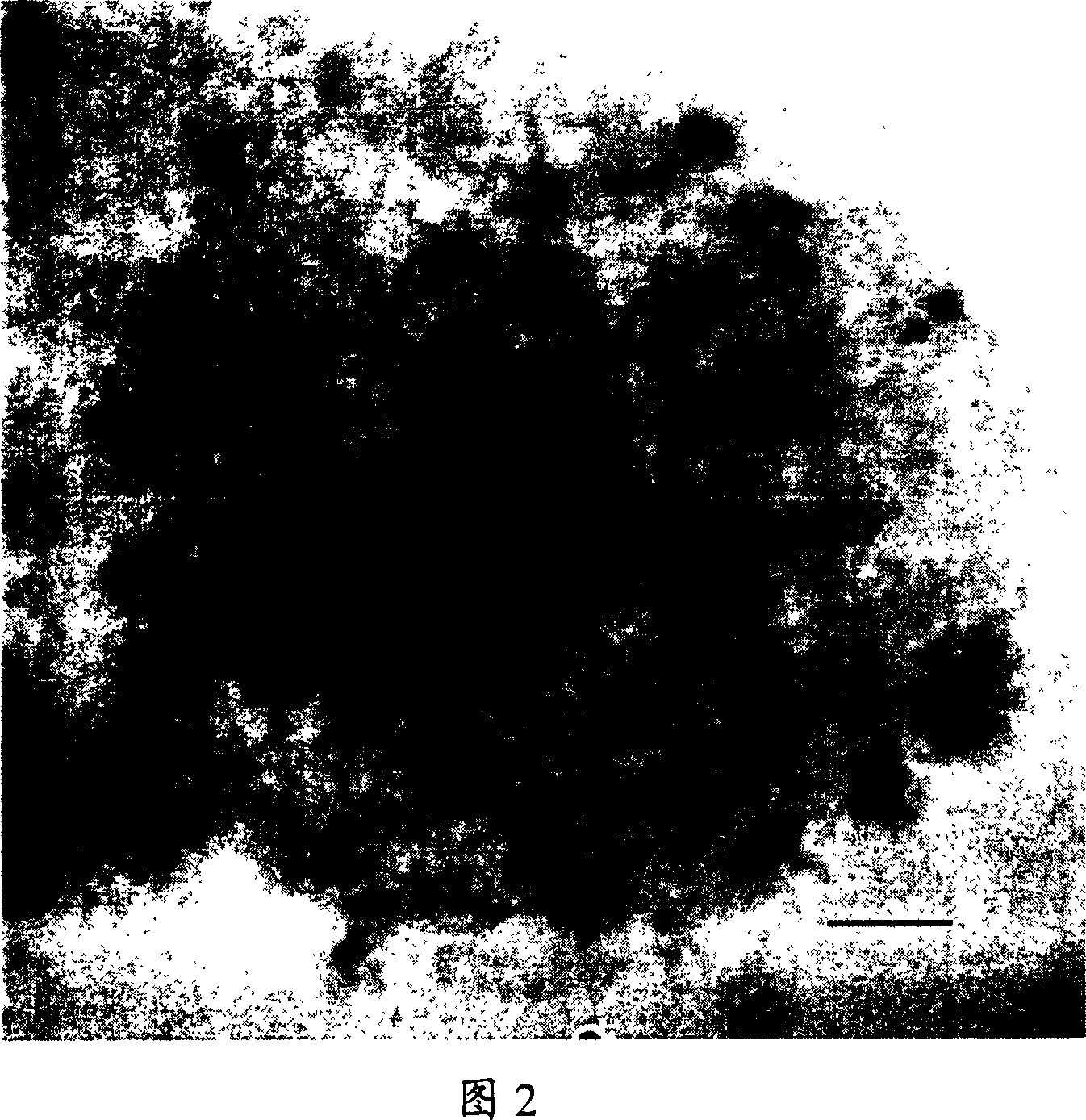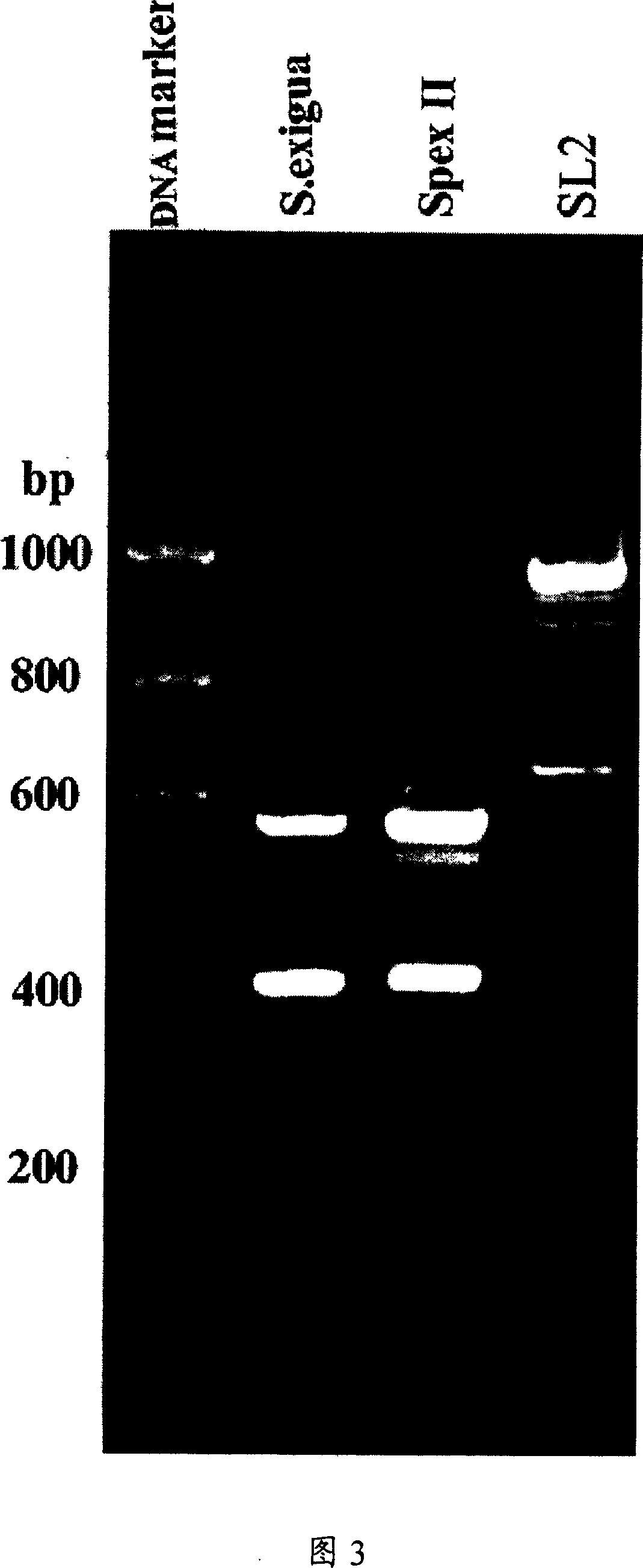Young beet armyworms fat body cell system for producing baculiform virus with high yields
A technology of beet armyworm and baculovirus, applied in the field of insect cell lines, can solve the problem of no cell lines
- Summary
- Abstract
- Description
- Claims
- Application Information
AI Technical Summary
Problems solved by technology
Method used
Image
Examples
Embodiment 1
[0036] Example 1. Establishment of fat body cell lines of beet armyworm larvae
[0037] Take the last instar beet armyworm larvae and immerse them in 70% ethanol solution for 10 minutes to carry out surface disinfection. Dissect the insect to remove the fat body tissue, keeping it as intact as possible during the manipulation. Wash the tissue 2-3 times with normal saline, and then use cell culture medium (based on TNM-FH, containing 100U / mL penicillin, 100U / mL streptomycin and 10% (v / v) fetal calf serum , pH=6.2) wash 1-2 times, put into a 25cm 2 Cell culture flasks were placed in a dark cell culture incubator at 27°C for 24 hours. Then add 3mL of the above-mentioned cell culture medium, and culture under the same conditions. Note that the key to the successful establishment of cell lines by this method is to make the tissue block stick to the bottom of the cell culture flask and not suspend the tissue block in the cell culture medium. After that, suck out half the amount ...
Embodiment 2
[0038] The biological characteristic observation and determination of embodiment 2.Spex II
[0039] (1) Morphological characteristics: Observed under a microscope, the cell line is usually suspended in the culture medium, and there are three types of cell shapes: round, spindle-shaped, and macrophage-like (Figure 1). In Spex II, round cells accounted for 85.7%, with an average diameter of 14.7 μm; spindle cells accounted for 12.7%, with a length of about 16.0-41.9 μm (average 25.3 μm), a width of about 8.4-16.0 μm (average 11.2 μm); about 1.6% of The cells were macrophage-like and ranged in diameter from 18.2-31.4 μm.
[0040] (2) Cell growth: at 27°C, the population doubling time of the 10th generation of the two cell lines in TNM-FH medium containing 10% fetal bovine serum, 100 U / mL penicillin, and 100 U / mL streptomycin 108.8hr and 156.8hr respectively. The highest cell density can reach about 1.3×10 6 cells / mL.
[0041] (3) Karyotype analysis: the 10th generation cells ...
Embodiment 3
[0044] Example 3. Determination of virus sensitivity and yield
[0045] Spex II is sensitive to beet armyworm nuclear polyhedrosis virus: inoculate Spex II with SeNPV budding virion BV at a concentration of 0.001 larvae equivalent / ml, and after culturing for 10 days, harvest cells and virus polyhedrons, and use a hemocytometer under a microscope The number of viral polyhedrons was counted. As a result, Spex II amplified SeNPV could produce 1.8×10 8 Production of PIBs. At the same time, typical cytopathological features can be observed, that is, the nucleus is enlarged and contains a large number of polyhedron particles (Figure 4). And it can be passed down continuously for at least 3 generations.
[0046] Bioassays were performed on late 2nd instar larvae of Spodoptera exigua using viral polyhedrons produced by the cell line as described above. Its method is as follows: after Spex II inoculates SeNPV virus 10 days, collect cell and culture fluid thereof, add the 10% sodium ...
PUM
| Property | Measurement | Unit |
|---|---|---|
| diameter | aaaaa | aaaaa |
| diameter | aaaaa | aaaaa |
Abstract
Description
Claims
Application Information
 Login to View More
Login to View More - R&D
- Intellectual Property
- Life Sciences
- Materials
- Tech Scout
- Unparalleled Data Quality
- Higher Quality Content
- 60% Fewer Hallucinations
Browse by: Latest US Patents, China's latest patents, Technical Efficacy Thesaurus, Application Domain, Technology Topic, Popular Technical Reports.
© 2025 PatSnap. All rights reserved.Legal|Privacy policy|Modern Slavery Act Transparency Statement|Sitemap|About US| Contact US: help@patsnap.com



